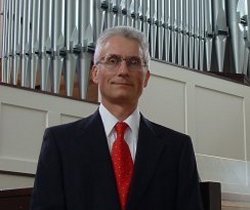
| | Organist | Accordionist | Composer | Conductor | Author | Educator |

 |
Henry Doktorski
|
 |
February 12, 2005: Henry Doktorski performed as soloist with the Butler County (Pennsylvania) Symphony Orchestra in a performance of Tres Tangos by the Argentinean-born composer and bandon onist, Astor Piazzolla (1921-1992). (The bandon on is a type of button-accordion especially popular in South America.) The concert was conducted by Elisabeth Heath-Charles, the music director and conductor of the orchestra.

Tres Tangos was written in 1962 and premiered under the direction of Paul Klecky in 1963. The piece won the Hirsch Prize in the same year. It is scored for bandon on, harp, piano, percussion, and strings. The three movements are titled Allegro tranquillo, Moderato mistico, and Allegretto molto marcato.
After the Tres Tangos performance, Doktorski returned to the stage and performed as an encore his own Theme and Variation on Richard Roger's "Edelweiss," following which he accompanied soprano soloist and Butler native Evie Barnes in a medley of four love songs to commemorate Valentine's Day: Irving Gordon's Unforgettable, Burt Bacharach's Close to You and I'll Never Fall in Love Again, and Dolly Parton's I Will Always Love You.
The president of the Butler County Symphony Association, Robert C. Shoemaker, wrote, "Your performance of Tres Tangos by Piazzolla was beautifully executed. Your collaboration with Evie Barnes was also much appreciated. We realize your efforts in the arrangement of the medley and applaud your musical talents. The response to the concert has been very positive and we thank you for your part in making the evening such a success."
The Butler County Symphony manager, Virginia Netchi, wrote, "The Piazzolla was mesmerizing and your playing introduced many people to the sublime possibilities of the accordion. We hope other orchestras will invite you to play it with them also."
One very special guest at the concert was 72-year-old Joan Moyer, a classical accordion lover from Indianapolis, Indiana, who flew 800 miles round-trip to hear Doktorski perform. She said, "I have been following Henry's career on his website for the past four years or so and I have most of his recordings. I haven't heard a live accordion performance for many years - and this was the first one of this year."
Doktorski invited Mrs. Moyer to attend the Friday night dress rehearsal where he introduced her to the conductor and orchestra, and then treated her and soprano Evie Barnes to dinner at a local restaurant, where Mrs. Moyer spoke about attending accordion competitions in her youth and meeting Pietro Deiro and Charles Magnante. Doktorski said, "Mrs. Moyer is such a sweet and charming lady; and very easy to please: she only ordered a glass of Coke at the restaurant!"
Mrs. Moyer continued, "It seemed that I was spending a lot of energy, time and finances in traveling so far to see Henry's concert with the Butler Symphony. My co-workers called me a groupie, my brother called me a stalker, and my 94-year-old mother said I was nuts! So on the flight to Pennsylvania I wondered to myself whether it was going to be worth it. . . . And indeed, it was even more than I had hoped! The tone, clarity, preciseness, the accuracy of Henry's playing, his demeanor while playing! I enjoyed hearing him play in person. It was well worth the endeavor!"
To listen to excerpts from this concert, go to Sound Files.
About Astor Piazzolla:
Piazzolla was born in Argentina, and he spent much of his youth performing tangos. As a young man, however, he abandoned the tango and began classical compositional studies with Argentina's Alberto Ginastera and France's Nadia Boulanger.
Finding his classical compositions lacking in depth of feeling, Boulanger asked him about his own traditions. When it finally occurred to him to play her one of his own tangos, she replied, "This is Piazzolla. You must never abandon this." Under her tutelage she coaxed him to join his two external influences, that of classical music and his love of American jazz, to his native tango.
It was Piazzolla's dream to create a tango that would not only be dance music but concert music as well. "For me," Piazzolla said, "the tango was always for the ear rather than the feet." The results were as audacious and innovative as they were outrageous to prevailing trends. For in Argentina, you don't mess with the tango and go away unscathed. As a beloved music that helped to define a largely immigrant people, to give them a newfound identity in rough times, messing with the tango was messing with the fledgling national character.
So when Piazzolla returned to Buenos Aires from trips abroad, taxi drivers recognizing him through their rearview mirrors would harangue him, while others pulling up to the curb pulled right back out again. Musicians even came to threaten his life. A few once waited for him outside his house to work him over. One tango singer actually barged into a radio station where he was giving an interview and put a pistol to his head. "I was taking the old tango away from them," Piazzolla said. "The old tango, the one they loved was dying. And they hated me." But he took nothing away from them at all. By modernizing the form, by midwifing the birth of a far more profound music within the tango, Astor Piazzolla made it more eternal.
Piazzolla wrote over 750 compositions, including concerti, operas, film and theater scores, and made over seventy records.
|